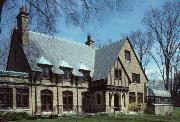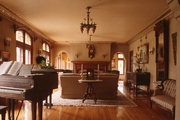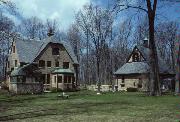Property Record
13030 N CEDARBURG RD
Architecture and History Inventory
| Historic Name: | EDWIN J. NIEMAN, SR. HOUSE |
|---|---|
| Other Name: | NIEMAN FOX FARM MANSION |
| Contributing: | |
| Reference Number: | 64385 |
| Location (Address): | 13030 N CEDARBURG RD |
|---|---|
| County: | Ozaukee |
| City: | Mequon |
| Township/Village: | |
| Unincorporated Community: | |
| Town: | |
| Range: | |
| Direction: | |
| Section: | |
| Quarter Section: | |
| Quarter/Quarter Section: |
| Year Built: | 1928 |
|---|---|
| Additions: | |
| Survey Date: | 1993 |
| Historic Use: | house |
| Architectural Style: | English Revival Styles |
| Structural System: | |
| Wall Material: | Brick |
| Architect: | HERMAN H. BRUNS |
| Other Buildings On Site: | |
| Demolished?: | No |
| Demolished Date: |
| National/State Register Listing Name: | Nieman, Edwin J., Sr., House |
|---|---|
| National Register Listing Date: | 4/12/1996 |
| State Register Listing Date: | 8/4/1995 |
| National Register Multiple Property Name: |
| Additional Information: | A 'site file' exists for this property. It contains additional information such as correspondence, newspaper clippings, or historical information. It is a public record and may be viewed in person at the State Historical Society, Division of Historic Preservation. North of Thiensville, on twenty-six densely wooded acres, sits one of Wisconsin’s most impressive mansions. Nieman’s extraordinary Neo-Tudor manor was designed by Milwaukee architect and interior designer Herman Bruns, who trained at the art institutes of Milwaukee and Chicago. Even the structure of the house is remarkable. The twenty-room mansion is built of reinforced concrete on a steel frame, with brick veneer, making it fire resistant. Bruns juxtaposed shapes, masses, textures, and colors to create a highly artistic expression of its style, inspired by late-medieval England’s grand manor houses. The roof is steeply pitched, multi-gabled, and clad with slate, with copper-roofed wall dormers breaking through the roofline. The walls are made of tan wire-cut brick, and false half-timbering, filled with brick laid in herringbone and basket-weave patterns, ornaments much of the second story. The main facade faces a curved lawn, edged by a fieldstone retaining wall. The gabled entry is set in an elliptically arched surround, whose spandrels display a Tudor rose. The door, of bronze sheeting over oak, features a large glazed panel protected by a wrought-bronze grille. On the east elevation, a glass conservatory’s Tudor-arched gable features leaded art-glass depicting a flower-filled vase. Art glass and highly decorative ceilings create an unusually elaborate interior, each room with its own theme. The sumptuous stair hall suggests wealth and luxury with its stenciled ceiling, ornamental wrought-iron stair rail, and statuary niche filled with a bronze goddess. Beyond an arched opening, the living room is equally opulent. Vine leaves and grapes ornament a gilded plaster cornice, and the ornate fireplace features a Neo-Tudor mantelpiece carved with linenfold, strapwork, and ropes. In the main dining room, a floral pattern incises the plaster walls, and a silver leaf pattern set against a dark blue background edges the ceiling. Concrete-and-steel beams, painted, grained, and varnished to resemble wood, divide the ceiling into panels, each printed with a floral pattern of green leaves, simplified Tudor roses, and fruit. Pairs of French doors link the dining room to the conservatory. Its focal point is a fountain embellished with bas-relief tiles and life-size herons, frogs, and plants, crafted in copper. Equally exquisite is the naturalistic vine design winding along a band of windows, its leaves fashioned of stained glass in several shades of green, its sinuous stem made of lead. Even the Neo-Tudor two-car garage displays Bruns's flourishes in a large clock in one half-timbered gable end. Under an elaborate wooden canopy and flanked by carved and painted wooden figurines, it suggests the elaborate mechanical clocks of Germany and Switzerland. One artistic theme appears repeatedly throughout this resplendent estate: the silver fox, seen on the garage’s weather vane, the bronze grille over the front door, and the chimney breast in the billiards room, where the architect himself painted a mural of a fox in the woods. The Fromm Brothers-Nieman Company was the nation's largest breeder of silver foxes for the fur industry. When the popularity of fox coats waned, the company became a major mink breeder. It also financed medical research into the causes and treatment of distemper and encephalitis. |
|---|---|
| Bibliographic References: | BLUEPRINTS. Buildings of Wisconsin manuscript. |
| Wisconsin Architecture and History Inventory, State Historic Preservation Office, Wisconsin Historical Society, Madison, Wisconsin |





